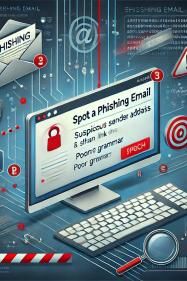Phishing attacks are a top concern in cybersecurity, targeting individuals and organizations alike. These attacks use deceptive emails, messages, and websites to trick victims into divulging sensitive information. Effective phishing detection is critical to preventing these threats. At Arsen, we specialize in cybersecurity training, helping employees recognize phishing attempts and use tools to enhance their security. Here, we explore advanced tools and techniques that can bolster your phishing detection capabilities.
Advanced Phishing Detection Tools
There are numerous tools available to help detect phishing attempts before they compromise your data. Here are some of the most effective solutions:
1. Email Filtering Solutions
Email filtering tools are the first line of defense against phishing attacks. These tools scan incoming emails for known phishing markers, such as suspicious sender addresses, unusual content, and harmful attachments.
How They Work: Email filters use a combination of algorithms, blacklists, and machine learning to identify and block phishing emails before they reach the user’s inbox. They flag suspicious messages and may quarantine them for further review.
Popular Tools: Microsoft Defender for Office 365, Proofpoint, and Barracuda Essentials are widely used email security solutions that include phishing detection capabilities.
2. Web Filtering and URL Scanners
Phishing attacks often involve malicious links leading to fake websites. Web filtering tools and URL scanners analyze web traffic, blocking access to known phishing sites and warning users of potentially dangerous URLs.
How They Work: Web filters compare URLs against a database of known phishing websites and use machine learning to analyze the structure of new URLs for phishing characteristics. URL scanning tools, like URLScan.io and VirusTotal, allow users to inspect suspicious links without visiting them directly.
Best Practice: Always scan unfamiliar URLs using these tools before clicking, especially if they come from unexpected sources.
3. Anti-Phishing Browser Extensions
Many web browsers support extensions designed to detect and block phishing websites. These extensions can alert users when they attempt to visit a known phishing site or if a website's URL and content resemble a known legitimate site but have subtle differences.
- Examples: Popular extensions include Avast Online Security, Bitdefender TrafficLight, and Norton Safe Web. They analyze web pages in real-time and warn users of potential phishing risks.
Effective Phishing Detection Techniques
In addition to using tools, adopting best practices and techniques is vital for detecting phishing attempts:
1. User Education and Awareness
One of the most effective ways to detect phishing is through user awareness. Training employees to recognize common phishing tactics, such as fake login pages, unsolicited attachments, and urgent requests for personal information, can significantly reduce the risk of falling victim.
- Next-Generation Training: At Arsen, we offer comprehensive awareness programs that use simulated phishing attacks to train employees in real-world scenarios, enhancing their detection skills.
2. Multi-Factor Authentication (MFA)
While not a direct phishing detection tool, enabling multi-factor authentication (MFA) adds an additional security layer. Even if an attacker obtains login credentials through phishing, MFA requires a second verification step (e.g., a code sent to a phone) to access accounts.
- How It Helps: MFA reduces the likelihood of successful phishing attacks by ensuring that stolen credentials alone are not enough to compromise an account.
3. Email and URL Inspection Techniques
Train users to inspect emails and URLs carefully:
Hover Over Links: Encourage employees to hover over links in emails to reveal the actual destination URL. If it looks unfamiliar or mismatched with the supposed sender, it could be a phishing attempt.
Check Sender Addresses: Teach users to scrutinize the sender's email address for signs of spoofing, such as slight misspellings or unusual domains.
Conclusion
Effective phishing detection requires a combination of advanced tools, techniques, and user awareness. Email filters, web filtering, and browser extensions play a crucial role in identifying and blocking phishing attempts, while training employees in phishing recognition techniques strengthens your organization's defense.
At Arsen, we provide next-generation cybersecurity awareness training tailored to your organization's needs, helping employees become your first line of defense against phishing attacks. Equip your team with the skills and tools to secure your communications and data.

